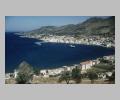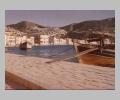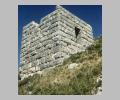| Summary: | Sanctuary of Hera. |
| Type: | Sanctuary |
| Region: | Sporades |
Periods:
Dark Age
Geometric
Archaic
Classical
Hellenistic
Roman
Physical:
The Heraion is located in marshy ground at the mouth of the river Imbrasos ca. 6 km W of the ancient capital city of Samos.
Description:
The earliest evidence for occupation at the site goes back to the Early Bronze Age, but the first structures of a definite religious character (altar and temple) date to the Dark Ages.
The sanctuary may have served a local Carian divinity originally, but the Hellenic religion probably arrived with the early Ionian colonists. According to Greek myth, it was here, beside a sacred bush, that Hera was born and married. A festival was held every year at the Heraion to celebrate the marriage of Hera and Zeus.
In the mid 6th century B.C. the sanctuary was enlarged and embellished during the reign of Polycrates and the 1st Great Hera Temple was built by the architect Rhoikos.
At ca. 530 B.C. Samos was captured by the Persians and the Hera Temple was destroyed by fire. A 2nd Great Temple was started at the end of the 6th century B.C., but it was never completed.
Samos was a member of the Delian League and became an Athenian colony in 365 B.C. After 190 B.C. Samos came under the control of Pergamon and finally under Roman rule. The sanctuary continued to develop throughout the Hellenistic and Roman periods, but was plundered a number of times by pirates and barbarians during its later history. It was also plundered by Antony in 39 B.C., but Augustus restored many of its art works.
Exploration:
Visited by Society of Dilettanti in 1812 and Ross in 1841. Minor test excavations by Gerard, Clerc, Kavvadias and Sophulis at end of 19th century. Excavated by German Archaeological Institute 1910-14, 1925-39, and since 1952.
Sources Used:
Other Bibliography:





